If you’re a beginner grower looking for the perfect introductory houseplant, then Devil’s Ivy might just be the best option for you. It is an extremely popular houseplant thanks to the fact that it is almost impossible to kill and it stays green even in low-light conditions, meaning it has naturally become widely grown in households across the globe.
With broad, glossy-green heart-shaped leaves that produce an abundance of trailing leafy growth, this wonderful plant can easily brighten up any space in your home with its gorgeous splashes of colour.
Here is your full guide to growing and caring for Devil’s Ivy.
More...
Devil's Ivy Description Table
Genus: | Epipremnum |
|---|---|
Species: | E. aureum |
Family: | Araceae |
Common Names: | Devil’s Ivy, Devil's Vine, Golden Pothos, Money Plant |
Location: | Indoor |
Type: | Plant, evergreen vine |
Growth: | 3 to 6 metres tall and wide |
Sun requirements: | Full sun |
Foliage Colour: | Green, variegated |
Flower Colour: | Purple to green spathes (rarely indoors) |
Flowering: | Spring to summer (once mature) |
Maintenance level: | Low |
Poisonous for pets: |
Getting to Know Devil’s Ivy

This evergreen vine features lime-green variegated foliage with aerial roots that can grow, spread and climb in all directions, meaning it allows for many creative and decorative applications within your home.
It is easy to grow and care for with leaves that are known to purify the air of common toxins. Though it has a shy-flowering nature, very rarely producing flowers indoors, this plant is considered one of the most decorative and ornamental houseplants, especially for beginners.
Often incorrectly labelled as Philodendron (like the Philodendron ‘Pink Princess’) or Scindapsus in many nurseries, devil’s ivy is botanically named Epipremnum aureum and forms a part of the Araceae family.
Native to the Moorea Society Islands of French Polynesia, it has now become widespread in subtropical and tropical regions, thriving in temperate climates with healthy humidity levels.
Other common names include golden pothos and money plant. With many exciting cultivars to choose from, there’s bound to be the perfect pick for your needs.
In cultivation, this tough plant grows to around 3 to 6 metres tall and wide but due to its spreading habit, this can often be a little different depending on conditions.
Commonly used as a decorative houseplant, it can be grown in hanging baskets or along wall trusses where it can drape and cascade luxuriously or it makes for an excellent potted plant for container growing.
Regardless of how you choose to grow your money plant, it's bound to add spectacle and colour to any setting.
Popular Epipremnum aureum Cultivars
Epipremnum aureum ‘Golden Pothos’
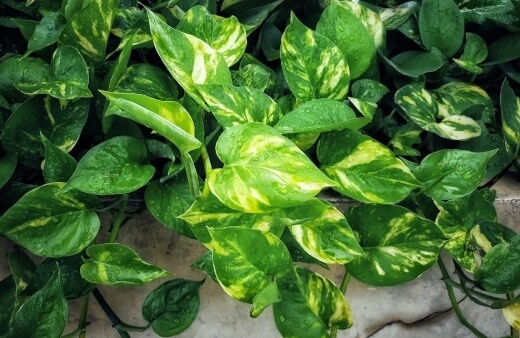
The most popular, tough and widely grown cultivar. This is the variety that we are mainly discussing in this article. It features trailing stems with glossy light-green heart-shaped leaves, variegated slightly with white.
Epipremnum aureum ‘Snow Queen’
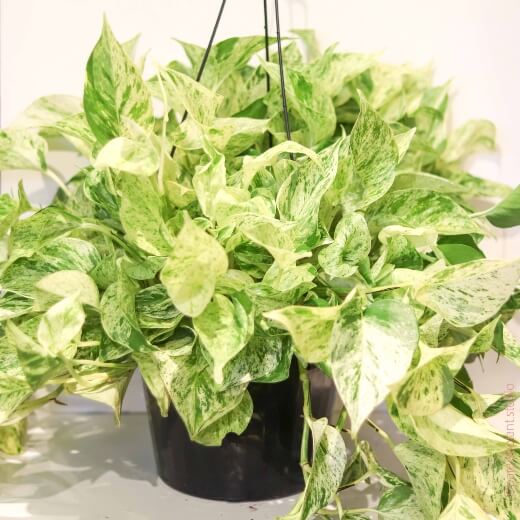
Source: paraisoplant.studio
This gorgeous variety shares many of the same features and growing habits as the original but with a lot more white in the leaf’s variegation, hence the name “Snow Queen”. It is just as accessible and easy-going.
Epipremnum aureum ‘Marble Queen’
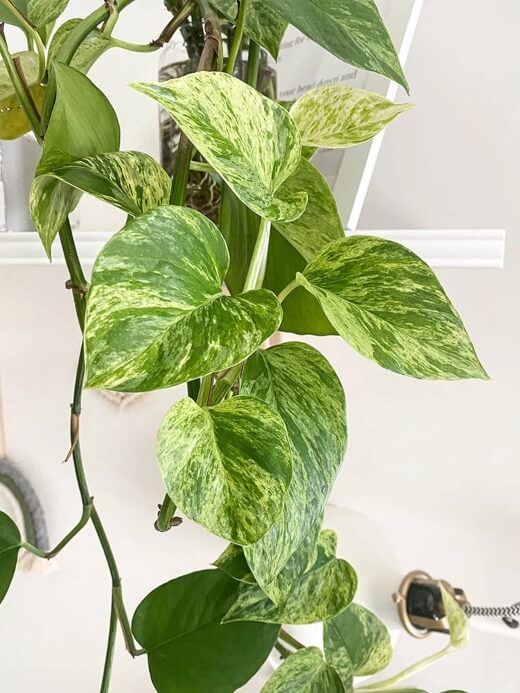
Source: blog.mytastefulspace.com
A beloved tropical evergreen cultivar of devil’s ivy, this variety features more heavily variegated foliage than the original with a stark contrast of light-green and white presented as streaks and marks on the broad leaves.
It grows a little more compact, making it perfect as a potted houseplant.
Epipremnum aureum ‘Jade’
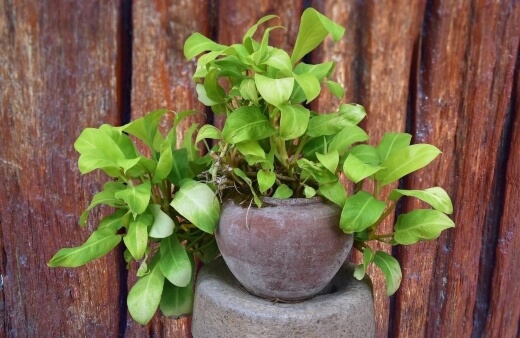
This variety is still gaining popularity and produces more green in its leaves with far less white variegation. It features more of a contrast between dark-green and light-green in its leaves.
How to Grow Devil’s Ivy
Devil’s ivy is easily propagated using cuttings. However, cuttings can be susceptible to diseases such as root rot and leaf spot if care is not taken when striking them.
Alternatively, young and healthy plants are available at your local nurseries or online retailers that can quickly be established in your desired medium and location.
For any of the specific cultivars, nursery plants are especially recommended.
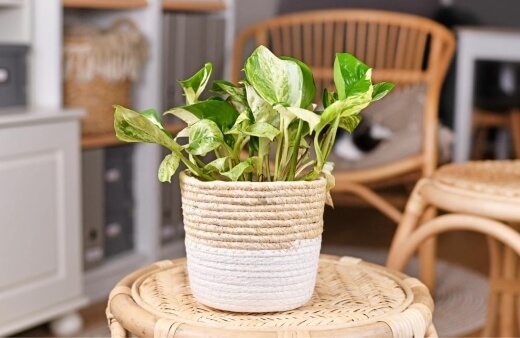
Ideal Conditions for Planting Golden Pothos
It should be good to know that this robust plant can survive even in poor growing conditions. Hence why it is so endorsed for those new to growing houseplants.
As long as you can give your golden pothos these basic growing conditions, it will thrive and present very little hassle for you overall.
Lighting Condition
Bright but indirect and filtered or diffused light is preferred but it can also grow in partly shaded to even fully shaded positions. The less light it gets, however, the less vivid and variegated the foliage will be.
Try to completely avoid harsh direct light as this can quickly scorch the leaves.
Best Soil for Devil’s ivy
Devil’s ivy will need light, porous, aerated and well-draining soil to thrive. This will also ensure it is as well-protected from disease as possible. A high-quality potting mix with some organic matter, such as compost should work great.
Ideal Temperature & Humidity
This evergreen vine grows best in warm and humid environments. This is why it is mainly widespread in temperate climates. The ideal temperature range for best growth is 17 to 30°C.
Humidity levels will need to be elevated, especially in the cooler months. Additional misting or placing your plant on top of a pebble tray filled with water can quickly help with increasing humidity.
How to Propagate Devil’s Ivy
Watch this video as Nathan Schwartz from Aussie Green Thumb shows us how to propagate the Golden Pothos (Devil's Ivy):
Propagating Devil’s Ivy Using Cuttings
- Cuttings should be taken and rooted in spring to early summer.
- Take cuttings of stems or stem tips with root nodes on them (little bumps along the stem).
- Submerge the base of your cuttings into some water for about 2 to 3 weeks to start seeing new root growth. Try to avoid submerging any leaves.
- Place the submerged cuttings in a warm location that gets filtered light like a window sill or somewhere similar.
- Once you see new shoots, you can plant the cut vines into soil to grow and develop further.
- Prepare containers filled with high-quality potting mix.
- Water gently to help settle the plant in the new soil.
- Keep moist but not soggy to avoid potential disease. Let the top layer of soil dry before watering again.
Helpful Guide: How to Take Cuttings: Ultimate Propagation Guide
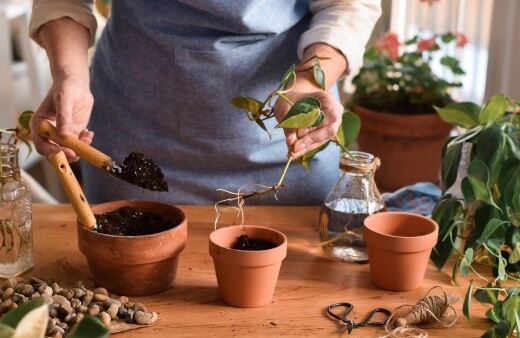
Planting a Nursery Plant in a Pot
- Choose a pot or container with good drainage and fill it with a high-quality potting mix.
- Gently remove your plant from its current container and lightly tousle the roots loose. Gently cut away any roots that are severely tangled.
- Position your money plant in the centre of the new pot and slowly backfill with the potting mix. Gently firming down once positioned.
- You can lightly prune the foliage to encourage healthy new growth in the new container.
- Water well after planting.
- To help protect your plant from possible disease or infestation during establishment, you can research and purchase a fungus and insect oil or spray that you can apply to your mix.
- Only water the potting mix when it is dry to the touch.
- To give your plant an extra boost, you can feed it with an indoor plant fertiliser or similar slow-release fertiliser between spring to autumn.
Devil's Ivy Care Tips
This plant is drought-tolerant so don’t worry too much about underwatering it. Overwatering can quickly lead to rotting issues. It can’t withstand frost though so try to avoid exposure to freezing temperatures.

Watering Golden Pothos
Water only when the top layer of soil feels dry. You can check by placing your index finger into the soil to make sure it needs water. This is usually every week to two weeks. The roots must be moist but never soggy.
What Fertiliser to Use
Feed with a balanced liquid fertiliser every fortnight throughout spring to autumn for healthy growth. A similarly controlled-release fertiliser for houseplants can also be used. Try to avoid fertilising over the winter months.
Check out our 2022 Yates Fertiliser buying guide and product reviews here for more in-depth information.
Pruning Devil’s Ivy
You will need to trim back the trailing stems to control and enhance your plant's shape as it grows otherwise it can quickly grow out of control and start to take over.
Regularly prune the stems of your plant, always being sure to leave a healthy amount of foliage at the end. Remove any dead, damaged or yellowing leaves as needed.
You can use a pair of clean and sharpened scissors or pruning shears (If you don’t have one yet, refer to our pruning shears buying guide). You can also simply bend the stems back with your hands and they should snap.
Repotting
This plant is a vigorous grower and will need to be repotted every 2 years or so once it has outgrown its current container. You will know it’s time to repot when you see shoots appearing from the bottom of the container.
Repot into a fresh, quality potting mix. You can also mix some of the old soil in as well. Choose a container that is one to two sizes larger each time.
Common Golden Pothos Pests & Diseases
Well-known as a resilient plant when it comes to pests and disease problems, most of the issues this plant can face are often related to soil conditions. Overwatering tends to be the biggest cause of fungal issues like root rot or leaf spots.
Limp or curling foliage is usually the result of drops in temperatures and cold drafts below 10°C so avoid placing your plant near any heating or cooling systems. A lack of water can also cause wilting foliage. (Check out this guide to find out other reasons why plants wilt and how to fix them.)
Be sure to stick to a consistent and healthy watering schedule, always first checking if additional water is needed.
Other smaller issues like spider mites and mealybugs can easily be treated by spraying the foliage with a garden insecticide or by using neem oil. Treat your plant every two to three weeks to irradicate these small pest problems.
Be sure to refer to our helpful guide for more information on the best natural and organic pest control for your plants.
Devil’s Ivy Frequently Asked Questions

Is Devil’s Ivy invasive?
The plant gets its name from the fact it is very hard to kill and that it is considered an invasive species in many regions if grown outdoors.
Is Devil’s Ivy good for bedrooms?
Being a climbing and trailing plant, it makes for a great addition in hanging baskets to bedrooms and even more humid locations like the bathroom or kitchen.
How long does Devil’s Ivy live?
When well cared for and well maintained, this plant can live for five to ten years on average. Interested in growing other easy-going houseplants with your devil’s ivy?
Be sure to check out our other helpful guides below:

Decorate and Dazzle Your Indoor Spaces with Devil’s Ivy
A fantastic option for beginners or for those who are looking for a very low-maintenance addition to their houseplant collections, this plant also offers stunning texture and colour for any setting within a home.
With its notoriously variegated foliage and with many exciting cultivars to choose from, there’s bound to be the perfect pick for your plant needs.
Whether hung to cascade and drape or potted in a decorative container, devil’s ivy can quickly elevate the spectacle of your home while also cleaning the air of common toxins.
Published on July 19, 2023 by Maisie Blevins
Last Updated on February 26, 2024




